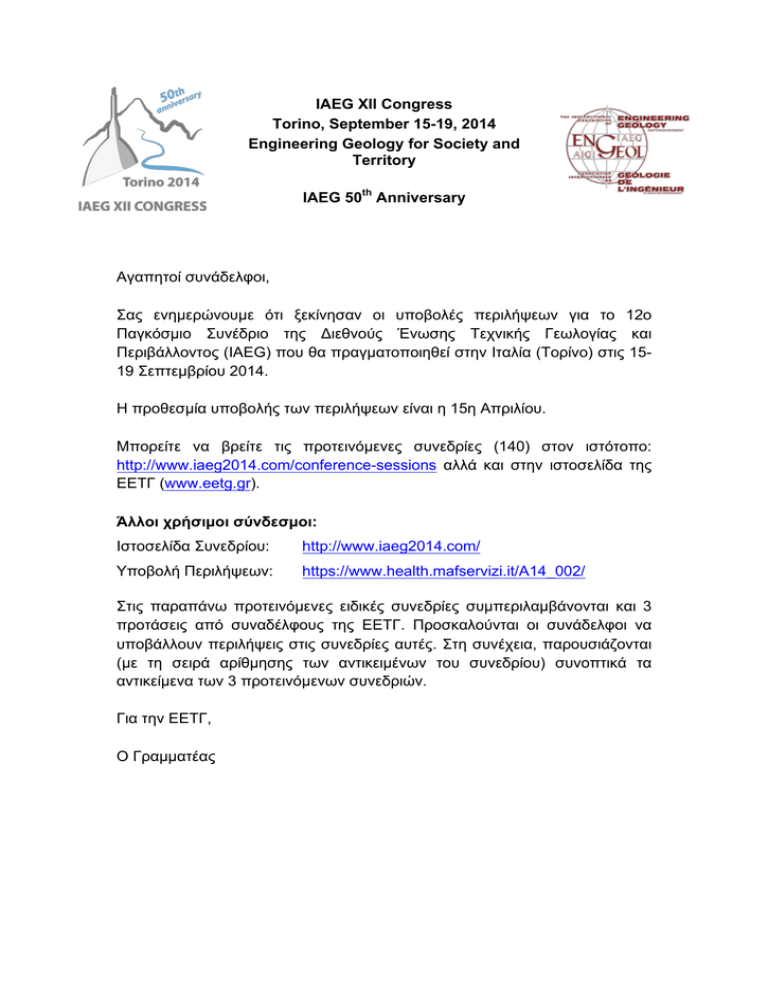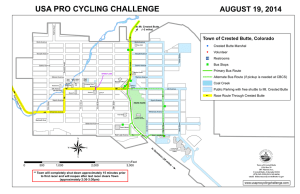
IAEG XII Congress
Torino, September 15-19, 2014
Engineering Geology for Society and
Territory
IAEG 50th Anniversary
Αγαπητοί συνάδελφοι,
Σας ενηµερώνουµε ότι ξεκίνησαν οι υποβολές περιλήψεων για το 12ο
Παγκόσµιο Συνέδριο της Διεθνούς Ένωσης Τεχνικής Γεωλογίας και
Περιβάλλοντος (IAEG) που θα πραγµατοποιηθεί στην Ιταλία (Τορίνο) στις 1519 Σεπτεµβρίου 2014.
Η προθεσµία υποβολής των περιλήψεων είναι η 15η Απριλίου.
Μπορείτε να βρείτε τις προτεινόµενες συνεδρίες (140) στον ιστότοπο:
http://www.iaeg2014.com/conference-sessions αλλά και στην ιστοσελίδα της
ΕΕΤΓ (www.eetg.gr).
Άλλοι χρήσιµοι σύνδεσµοι:
Ιστοσελίδα Συνεδρίου:
http://www.iaeg2014.com/
Υποβολή Περιλήψεων:
https://www.health.mafservizi.it/A14_002/
Στις παραπάνω προτεινόµενες ειδικές συνεδρίες συµπεριλαµβάνονται και 3
προτάσεις από συναδέλφους της ΕΕΤΓ. Προσκαλούνται οι συνάδελφοι να
υποβάλλουν περιλήψεις στις συνεδρίες αυτές. Στη συνέχεια, παρουσιάζονται
(µε τη σειρά αρίθµησης των αντικειµένων του συνεδρίου) συνοπτικά τα
αντικείµενα των 3 προτεινόµενων συνεδριών.
Για την ΕΕΤΓ,
Ο Γραµµατέας
1. Topic:
Landslide Processes
Session:
2.32 - Rockfall risk assessment and management - current practice and
developments
Brief Description of Session:
The session scope is to present current practice and recent developments on
the identification of rockfall phenomena and the assessment and
management of rockfall risk on human activities and infrastructure
(transportation infrastructure, inhabited areas, national heritage sites). The
Session is of great interest to geoscientists in Europe and throughout the
world. Universities and research Institutes have performed state-of-the-art
research on the Session topic and will be invited to present their research
results.
The number of Workshops organised recently, in Europe and worldwide
highlights the importance of the session topic and the need for knowledge
exchange. The Session will be structured according to the following topics: A)
Rockfall Risk Rating Systems. B) Rockmass characterisation - instability. C)
Rockfall trajectory analysis (experiments and modelling). D) Advanced
techniques for monitoring rock slope instabilities. E) Hazard mapping, risk
assessment, management and mitigation.
Convener: Dr Haris Saroglou
Co-Convener: Fred Berger Young Researcher: Pavlos Asteriou
2. Topic:
Applied geology for major engineering projects
Session:
6.15 - Properties and Behaviour of Weak and Complex Rock Masses in Major
Engineering Projects
Brief Description of Session:
Numerical analysis and computational methods in geotechnical engineering
are fields where great progress has been achieved. However, in the case of
weak and complex rock masses, the results still involve uncertainties due to
the difficulties in the reliable estimation of intact rock properties and the
realistic quantification of rock mass properties and behaviour. The special
features of these rock masses regarding both their structure and lithology
impose a more specialized research. The weak rock masses could be cases
with very low intact rock properties, highly tectonized or/and weathered rock
masses, rock masses with members of low strength and/or inherent
heterogeneity. This Session may contain papers on weak and complex rock
masses, regarding in situ and laboratory testing, characterization,
geotechnical classification, design parameters, behaviour, reinforcement and
support measures and performance of the construction method adopted in the
design approach according to the engineering project.
Convener: Dr Vassilis Marinos
Co-Convener George Stoumpos Young Researcher: Petros Fortsakis
3. Topic:
Preservation of cultural heritage
Session:
8.2 - Engineering Geology and Preservation of Cultural Heritage
Brief Description of Session:
Monuments reflect the image of the civilization and describe its evolution
during the centuries. They combine harmony with magnificence and beauty
with measure. In this framework, the monuments need protection particularly
in regions where the seismotectonic regime is active, and the geomechanical
conditions are complex. Phenomena like settlement and slope movement as
well as earthquakes and ground water activity contribute to the damage of the
historical buildings and the archaeological site. The investigation of
weathering of building stones and mortars is very important for determining
the most appropriate consolidation and restoration methods. It is obvious that
the common ground stabilization methods are not always possible to be used
in monuments because of their probable incompatibility to the historical and
architectural character of the site. The compatibility of conservation with the
historic materials and structures becomes a critical factor for the selection and
development of appropriate techniques. For this reason, scientific groups
perform a research study on specific conservation techniques. In the selection
of the stabilization methods, consideration is given to a number of factors
including a) the material lithotypes, b) the compatibility of mortars and stones
with the original ones, c) the stability of the ground in relation to the tectonic, d)
the ground water conditions, e) the degree of hazard and risk and h) the
necessity to reduce or eliminate the hazard. In the present time, the scientific
society establishes innovative techniques for reducing damages due to
atmospheric and geotechnical causes and for protecting monuments. It is a
multidisciplinary scientific work, which needs collaboration of specialities such
as archaeologists, chemists, geotechnics, architects, engineers and others
who can involve in the subject, by offering their specific knowledge and
experience. But the more important aspect is the comprehension and the
creation of conscience that the protection of cultural heritage needs
essentially a multidisciplinary approach, not only at scientific level but also at
social and political level. It is necessary, all people to understand that the
conservation of our cultural heritage is not only related to our past but also to
our future, because the future is based on the knowledge of the past and as
the Greek Nobelist George Seferis said “Because the statues are no longer
ruin, they are we”.
In this framework, the Commission No 16 (of “Engineering Geology and
Ancient Monuments and Archaeological Sites”), of the International
Association of Engineering Geology and the Environment (IAEG), proposes a
scientific session related on “Engineering Geology and Preservation of
Cultural Heritage”.
Convener: Prof. Basile Christaras
Co-Convener: Dr. Vassilis Marinos








